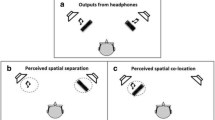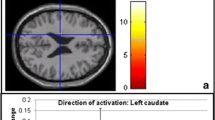Abstract
Rationale
Inhibition of return (IOR) refers to the delayed orienting of attention to previously inspected locations in favour of novel locations. Given its implications for visual attention and search, researchers have begun to investigate whether IOR may be impaired by the use of alcohol or illicit substances (e.g. d-amphetamine).
Objectives
The present paper reviews the existing literature exploring the impact of alcohol and other drugs on IOR through the use of the model spatial cueing task developed by Posner.
Results
Studies were located that investigated IOR paradigm with respect to either (a) acute effects of alcohol or other psychoactive substances and (b) hallucinogenic drug states as models for psychosis. Findings suggest that alcohol, d-amphetamine and some hallucinogens may alter the timecourse of IOR. This review also yields a critical qualitative analysis of the methodology of studies in this field of research and the implications of particular methodological features for interpreting previous findings.
Conclusions
The importance of using multiple stimulus onset asynchronies, employing a cue-back to centre paradigm and distinguishing between acute and chronic substance use are emphasized. Furthermore, questions are raised as to whether findings suggest an impact of psychoactive substances on the subcortical mechanisms that play a critical role in the generation of IOR or are an indirect effect resulting from impairment of the cortical mechanisms responsible for voluntary disengagement of attention. Directions for future research and particular methodological approaches are highlighted.




Similar content being viewed by others
Notes
We searched the PsycINFO, Medline and Web of Science databases to locate studies that examined (a) the acute effects of drugs on an IOR paradigm as tested in human drug administration laboratory studies or (b) IOR paradigm among chronic users of psychoactive substances. Included studies must have employed an IOR paradigm in individuals who had received an active dose of a psychoactive substance in a laboratory-based study. Databases were searched using the following search terms: inhibition of return, IOR, visual search, visual attention, orient* AND psychopharm*, pharm*, substance, drug, alcohol, stimulant, cannabis and hallucinogen. We also reviewed the reference lists of included articles.
References
Abroms BA, Fillmore MT (2004) Alcohol-induced impairment of inhibitory mechanisms involved in visual search. Exp Clin Psychopharmacol 12:243–250. doi:10.1037/1064-1297.12.4.243
Abroms BD, Gottlob LR, Fillmore MT (2006) Alcohol effects on inhibitory control of attention: distinguishing between intentional and automatic mechanisms. Psychopharmacology 188:324–334. doi:10.1007/s00213-006-0524-y
Aron AR, Dowson JH, Sahakian BJ, Robbins TW (2003) Methylphenidate improves response inhibition in adults with attention-deficit/hyperactivity disorder. Biol Psychiatry 54:1465–1468. doi:10.1016/S0006-3223(03)00609-7
Berlucchi G (2006) Inhibition of return: a phenomenon in search of a mechanism and a better name. Cogn Neuropsychol 23:1065–1074. doi:10.1080/02643290600588426
Catafau AM, Parellada E, Lomena FJ et al (1994) Prefrontal and temporal blood flow in schizophrenia: resting and activation technetium-99m-HMPAO SPECT patterns in young neuroleptic-naive patients with acute disease. J Nucl Med 35:935–941
Colzato LS, Hommel B (2008) Cannabis, cocaine, and visuomotor integration: evidence for a role of dopamine D1 receptors in binding perception and action. Neuropsychologia 46:1570–1575. doi:10.1016/j.neuropsychologia.2007.12.014
Colzato LS, Hommel B (2009) Recreational use of cocaine eliminates inhibition of return. Neuropsychology 23:125–129. doi:10.1037/a0013821
Cunha PJ, Nicastri S, de Andrade AG, Bolla KI (2010) The frontal assessment battery (FAB) reveals neurocognitive dysfunction in substance-dependent individuals in distinct executive domains: abstract reasoning, motor programming, and cognitive flexibility. Addict Behav 35:875–881. doi:10.1016/j.addbeh.2010.05.005
Danziger S, Fendrich R, Rafal R (1997) Inhibitory tagging of locations in the blind field of hemianopic patients. Conscious Cogn 6:291–307. doi:10.1006/ccog.1997.0312
Daumann J, Heekeren K, Neukirch A, Thiel CM, Moller-Hartmann W, Gouzoulis-Mayfrank E (2008) Pharmacological modulation of the neural basis underlying inhibition of return (IOR) in the human 5-HT2A agonist and NMDA antagonist model of psychosis. Psychopharmacology 200:573–583. doi:10.1007/s00213-008-1237-1
de Wit H, Enggasser MA, Richards JB (2002) Acute administration of d-amphetamine decreases impulsivity in healthy volunteers. Neuropsychopharmacology 27:813–825. doi:10.1016/S0893-133X(02)00343-3
Dorris MC, Klein RM, Everling S, Munoz DP (2002) Contribution of the primate superior colliculus to inhibition of return. J Cogn Neurosci 14:1256–1263. doi:10.1162/089892902760807249
Dukewich KR (2009) Reconceptualizing inhibition of return as habituation of the orienting response. Psychon Bull Rev 16:238–251. doi:10.3758/PBR.16.2.238
Easdon CM, Vogel-Sprott M (2000) Alcohol and behavioural control: impaired response inhibition and flexibility in social drinkers. Exp Clin Psychopharmacol 8:387–394. doi:10.1037/1064-1297.8.3.387
Fernandez-Serrano MJ, Perez-Garcia M, Rio-Valle JS, Verdejo-Garcia A (2010) Neuropsychological consequences of alcohol and drug abuse on different components of executive functions. J Psychopharmacol 24:1317–1332. doi:10.1177/0269881109349841
Fillmore MT (2007) Acute alcohol-induced impairment of cognitive functions: past and present findings. Int J Disabil Hum Dev 6:115–125. doi:10.1515/IJDHD.2007.6.2.115
Fillmore MT, Dixon MJ, Schweizer TA (2000) Alcohol effects processing of ignored stimuli in a negative priming paradigm. J Stud Alcohol 61:571–578
Fillmore MT, Rush CR, Abroms BD (2005) d-Amphetamine-induced enhancement of inhibitory mechanisms involved in visual search. Exp Clin Psychopharmacol 13:200–208. doi:10.1037/1064-1297.13.3.200
Fuentes LJ, Boucart M, Alvarez R, Vivas AB, Zimmerman MA (1999) Inhibitory processing in visuospatial attention in healthy adults and schizophrenic patients. Schizophr Res 40:75–80. doi:10.1016/S0920-9964(99)00044-4
Gouzoulis-Mayfrank E, Thelen B, Maier S, Heekeren K, Kovar K-A, Sass H, Spitzer M (2002) Effects of the hallucinogen psilocybin on covert orienting of visual attention in humans. Neuropsychobiology 45:205–212. doi:10.1159/000063672
Gouzoulis-Mayfrank E, Heekeren K, Voss T, Moerth D, Thelen B, Meincke U (2004) Blunted inhibition of return in schizophrenia—evidence from a longitudinal study. Prog Neuropsychopharmacol Biol Psychiatry 28:389–396. doi:10.1016/j.pnpbp.2003.11.010
Gouzoulis-Mayfrank E, Heekeren K, Timmerbeil A, Stoll M, Stock C, Obradovic M, Kovar K-A (2005) Psychological effects of (S)-ketamine and N, N-dimethyltryptamine (DMT): a double-blind, cross-over study in healthy volunteers. Pharmacopsychiatry 38:301–311. doi:10.1055/s-2005-916185
Gouzoulis-Mayfrank E, Heekeren K, Neukirch A, Stoll M, Stock C, Daumann J, Obradovic M, Kovar K-A (2006) Inhibition of return in the human 5HT2A agonist and NMCA antagonist model of psychosis. Neuropsychopharmacol 31:431–441. doi:10.1038/sj.npp.1300882
Guillot CR, Fanning JR, Bullock JS, McCloskey MS, Berman ME (2010) Effects of alcohol on tests of executive functioning in men and women: a dose response examination. Exp Clin Psychopharmacol 18:409–417. doi:10.1037/a0021053
Honey GD, Honey RAE, Sharar SR et al (2004) Impairment of specific episodic memory processes by sub-psychotic doses of ketamine: the effects of levels of processing at encoding and of subsequent retrieval task. Psychopharmacol 181:445–457. doi:10.1007/s00213-005-0001-z
Hoyer WJ, Semenec SC, Buchler NEG (2007) Acute alcohol intoxication impairs controlled search across the visual field. J Stud Alcohol Drugs 68:748–758
Huey ED, Wexler BE (1994) Abnormalities in rapid, automatic aspects of attention in schizophrenia: blunted inhibition of return. Schizophr Res 14:57–63
Kebir O, Ben Azouz O, Rabah Y, Dellagi L, Johnson I, Amado I, Tabbane K (2010) Confirmation for a delayed inhibition of return by systematic sampling in schizophrenia. Psychiatry Res 176:17–21. doi:10.1016/j.psychres.2008.10.010
Kerr JS, Hindmarch I (1998) The effects of alcohol alone or in combination with other drugs on information processing, task performance and subjective responses. Hum Psychopharamacol 13:1–9. doi:10.1002/(SICI)1099-1077(199801)13:1<1::AID-HUP939>3.0.CO;2-0
Klein RM (1988) Inhibitory tagging system facilitates visual search. Nature 334:430–431. doi:10.1038/334430a0
Klein RM (2000) Inhibition of return. Trends Cogn Sci 4:138–147. doi:10.1016/S1364-6613(00)01452-2
Klein RM (2004) Orienting and inhibition of return. In: Gazzaniga MS (ed) The cognitive neurosciences, 3rd edn. MIT, Cambridge, pp 545–559
Klein RM (2005) On the role of endogenous orienting in the inhibitory aftermath of exogenous orienting. In: Mayr U, Awh E, Keele S (eds) Developing individuality in the human brain: a tribute to Michael I. Posner. American Psychological Association, Washington, DC, pp 45–64
Lundqvist T (2005) Cognitive consequences of cannabis use: comparison with abuse of stimulants and heroin with regard to attention, memory and executive functions. Psychopharmacol Biochem Behav 81:319–330. doi:10.1016/j.pbb.2005.02.017
Lupianez J (2011) Inhibition of return. In: Nobre K, Coull J (eds) Attention and time. Oxford University Press, Oxford, pp 17–34
Lussier I, Stip E (2001) Memory and attention deficits in drug naive patients with schizophrenia. Schizphr Res 48:45–55. doi:10.1016/S0920-9964(00)00102-X
Mayer AR, Seidenberg M, Dorflinger JM, Rao SM (2004) An event-related fMRI study of exogenous orienting: supporting evidence for the cortical basis of inhibition of return. J Cogn Neurosci 16:1262–1271. doi:10.1162/0898929041920531
Molnar M, Boha R, Czigler B, Gaal ZA (2010) The acute effect of alcohol on various memory processes. J Psychophysiol 24:249–252. doi:10.1027/0269-8803/a000038
Mushquash AR, Fawcett MJ, Klein RM (2012) Inhibition of return and schizophrenia: A meta-analysis. Schizophr Res 135:55–61
Nigg JT, Wong MM, Martel MM et al (2006) Poor response inhibition as a predictor of problem drinking and illicit drug use in adolescents at risk for alcoholism and other substance use disorders. J Am Acad Child Adolesc Psychiatry 45:468–475. doi:10.1097/01.chi.0000199028.76452.a9
Posner MI, Cohen Y (1984) Components of visual orienting. In: Houma H, Bouwhuis DG (eds) Attention and performance X: control of language processes. Erlbaum, Hillsdale, pp 531–556
Posner MI, Rafal RD, Choate LS, Vaughan J (1985) Inhibition of return: neural basis and function. Cogn Neuropsychol 2:211–228. doi:10.1080/02643298508252866
Rafal RD, Posner MI, Friedman JH, Inhoff AW, Bernstein E (1988) Orienting of visual attention in progressive supranuclear palsy. Brain 111:267–280
Rafal RD, Calabresi PA, Brennan CW, Sciolto TK (1989) Saccade preparation inhibits reorienting to recently attended locations. J Exp Psychol Hum Percept Perform 25:730–746. doi:10.1037/0096-1523.15.4.673
Reay JL, Hamilton C, Kennedy DO, Scholey AB (2006) MDMA polydrug users show process specific central executive impairments coupled with impaired social and emotional judgement processes. J Psychopharmacol 20:385–388. doi:10.1177/0269881106063269
Samuel AG, Kat D (2003) Inhibition of return: a graphical meta-analysis of its time course and an empirical test of its temporal and spatial properties. Psychon Bull Rev 10:897–906. doi:10.3758/BF03196550
Sapir A, Soroker N, Berger A, Henik A (1999) Inhibition of return in spatial attention: direct evidence for collicular generation. Nat Neurosci 2:1053–1054. doi:10.1038/15977
Sapir A, Dobrusin M, Ben-Bashat G, Henik A (2007) Neuroleptics reverse attentional effects in schizophrenia patients. Neuropsychologia 45:3263–3271. doi:10.1016/j.neuropsychologia.2007.06.007
Tipper SP, Rafal R, Reuter-Lorenz PA et al (1997) Object-based facilitation and inhibition from visual orienting in the human split-brain. J Exp Psychol Hum Percept Perform 23:1522–1532. doi:10.1037/0096-1523.23.5.1522
Valenza E, Simion F, Umilta CL (1994) Inhibition of return in newborn infants. Infant Behav Dev 17:293–302. doi:10.1016/0163-6383(94)90009-4
Verbaten MN (2010) Deterioration of executive functioning in chronic ecstasy users; evidence for multiple drugs effects. Curr Drug Abuse Rev 3:129–138. doi:10.2174/1874473711003030129
Weissenborn R, Duka T (2003) Acute alcohol effects on cognitive function in social drinkers: their relationship to drinking habits. J Psychopharmacol 165:306–312
Author information
Authors and Affiliations
Corresponding author
Additional information
Janine V. Olthuis’ contribution to this manuscript was supported by a Canadian Institutes of Health Research Vanier Canada Graduate Scholarship and by a Killam Predoctoral Scholarship.
Appendix I
Appendix I
Rights and permissions
About this article
Cite this article
Olthuis, J.V., Klein, R.M. On the measurement of the effects of alcohol and illicit substances on inhibition of return. Psychopharmacology 221, 541–550 (2012). https://doi.org/10.1007/s00213-012-2725-x
Received:
Accepted:
Published:
Issue Date:
DOI: https://doi.org/10.1007/s00213-012-2725-x




